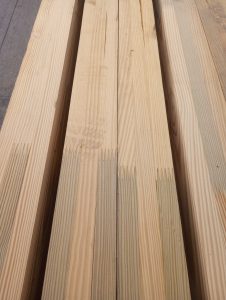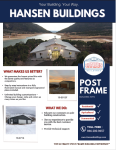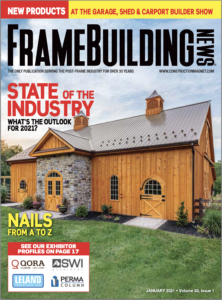Help, I am Going Crazy!
Reader DIRK in SPANISH FORK writes:
“I am planning to build a pole barn house. I get so confused with the different methods of doing things and the pros and cons of each. I plan to pour concrete piers with a post bracket. Not sure if a 6×6 post or 3 ply 2×6 is better? Maybe this is determined by the way trusses attach. My longest span is 50 ft on 10 ft o.c. If I need double trusses then I might not be able to sandwich the trusses between 2x6s on the laminated column unless i put four 2x6s. I have seen double trusses sitting in a notch. As far as the exterior walls I am not sure what method is better. Bookshelf/Commercial or Girts on outside and inside? Do I need sheathing on the exterior if I am doing a stone wainscot and LP type siding? Air/Water barrier details and how and where to install? Help me! I am going crazy!”
Help is on its way – so no need to go crazy!
 Your best column is going to be a glulam, hands down.
Your best column is going to be a glulam, hands down.
Solid sawn columns (e.g. a 6×6) are unlikely to be found kiln dried. This means they are going to be prone to warp, check and twist as they dry.
Strength: bending strength is a product of Sm (Section modulus – depth squared x width divided by six) multiplied by Fb (Fiberstress in bending). Sm for a 6×6 is 5.5 x 5.5 x 5.5 / 6 = 27.729. Fb for #2 DFL (Douglas Fir-Larch) posts and timbers is 750.
27.729 x 750 = 20,796.75
If nailing together three 2×6 #2 DFL Sm = 3 x 1.5 x 5.5 x 5.5 / 6 = 22.6875 Fb for #2 DFL 2×6 is 1170 and 3 members together gets a repetitive member increase of 15%
22.6875 x 1170 x 1.15 = 30,526
Our 3 ply glu-lams have a Sm of 18.058. Take this value times 3000 = 54,173 or 177% of three 2×6 nailed up.
Nailed up columns have some of their own challenges, they are very flexible in weak axis bending (pushing against the 5-1/2″ face). If nails shorter than 4-1/2″ are used and members are nailed from each side, more force is transmitted to the center of the three plies. In testing to failure, this center member fails prematurely nearly every time. As these members still act independent from each other, they are still prone to warp and twist.
You really want to use doubled (2 ply) trusses. A true double truss system, such as used by Hansen Pole Buildings, features trusses physically attached face-to-face by means of mechanical connectors (structural screws). This allows for two members to actually load share, reducing probabilities of one weak single truss failing and pulling a roof system down with it. It also minimizes need for lateral bracing.
Trusses should be set into a notch cut into one side of the column. Trying to utilize a center notch makes setting trusses exceedingly difficult and requires heavy equipment.
Bookshelf girts are really your best design solution. An externally mounted wall girt, on 10 foot bays, deflects too much to adequately support your siding choices. Bookshelf girts are far stiffer against wind loads, provide a deep insulation cavity and allow for a single member to be used.
 Your stone wainscot will require sheathing and I would not personally install LP siding without sheathing. An Omnidirectional water resistant barrier should be placed on exterior side of your sheathing (under siding).
Your stone wainscot will require sheathing and I would not personally install LP siding without sheathing. An Omnidirectional water resistant barrier should be placed on exterior side of your sheathing (under siding).
Please reach out to me any time with questions. My goal is to assist clients in getting structurally sound buildings they will love forever.
 DEAR KEVIN: I know of several builders who would think nothing of screwing steel liner panels to truss bottom chords spaced eight and even nine-foot on center. Personally, I feel like there is going to be some noticeable deflection at those spans, especially as liner panels tend to run towards 29 gauge’s thin side. It is also, obviously, going to depend upon what is being used for insulation. Blown in fiberglass is very light, cellulose or rock wool will be roughly three times as heavy.
DEAR KEVIN: I know of several builders who would think nothing of screwing steel liner panels to truss bottom chords spaced eight and even nine-foot on center. Personally, I feel like there is going to be some noticeable deflection at those spans, especially as liner panels tend to run towards 29 gauge’s thin side. It is also, obviously, going to depend upon what is being used for insulation. Blown in fiberglass is very light, cellulose or rock wool will be roughly three times as heavy. DEAR NORMAN: Actually, a typical 3 ply 2×6 true glu-laminated column, will be stronger than a solid sawn 6×6. This is especially true in Western states where solid sawn columns are typically Hem-Fir. Hem-Fir has a lower Fb (fiberstress in bending) than many other popular wood species. Now, some good news for you….Hansen Pole Buildings is expanding to provide metal connector plated trusses, as well as lumber and glu-laminated columns. In buying direct from a well-respected sawmill for lumber and a glu-laminated column manufacturer, we are cutting out scores of middlemen, resulting in us being able to deliver better quality materials, with shorter lead times and at competitive prices. Pricing should be available in roughly 30 days with deliveries to begin around mid-May.
DEAR NORMAN: Actually, a typical 3 ply 2×6 true glu-laminated column, will be stronger than a solid sawn 6×6. This is especially true in Western states where solid sawn columns are typically Hem-Fir. Hem-Fir has a lower Fb (fiberstress in bending) than many other popular wood species. Now, some good news for you….Hansen Pole Buildings is expanding to provide metal connector plated trusses, as well as lumber and glu-laminated columns. In buying direct from a well-respected sawmill for lumber and a glu-laminated column manufacturer, we are cutting out scores of middlemen, resulting in us being able to deliver better quality materials, with shorter lead times and at competitive prices. Pricing should be available in roughly 30 days with deliveries to begin around mid-May. DEAR BRIAN: I find concept of a plywood floor as opposed to slab-on-grade very appealing personally. Many years ago I lived in one side of a rental duplex in Coeur d’Alene, Idaho. I mention it as this duplex had radiant ceiling heat. It was fabulous as long as you were not under something (like your legs when sitting at a table). As heat rises, I would look towards radiant floor heat as my first choice (have it in our barndominium on South Dakota side of Lake Traverse). Fully engineered post frame, modest tastes, totally DIY, move in ready, budget roughly $70-80 per sft of floor space for living areas, $35 for all others. Does not include land, site prep, utilities, permits. If you hire it all done by a General Contractor, expect to pay 2-3x as much.
DEAR BRIAN: I find concept of a plywood floor as opposed to slab-on-grade very appealing personally. Many years ago I lived in one side of a rental duplex in Coeur d’Alene, Idaho. I mention it as this duplex had radiant ceiling heat. It was fabulous as long as you were not under something (like your legs when sitting at a table). As heat rises, I would look towards radiant floor heat as my first choice (have it in our barndominium on South Dakota side of Lake Traverse). Fully engineered post frame, modest tastes, totally DIY, move in ready, budget roughly $70-80 per sft of floor space for living areas, $35 for all others. Does not include land, site prep, utilities, permits. If you hire it all done by a General Contractor, expect to pay 2-3x as much.







